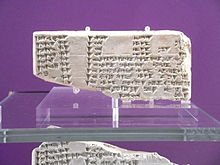Enuma Anu Enlil
The Enuma Anu Enlil (also EAE ) is a collection of around 7,000 Babylonian Omina texts. The cuneiform tablets are available in 70 series assignment texts . Enuma Anu Enlil means As [the gods] Anu and Enlil [...] .
Origin of the tablets
Archaeologists found the greatest number of cuneiform texts in the library of Aššurbanipal and in Babylon . The oldest texts go back to the first ancient Babylonian dynasty . Further processing followed during the conquest of Babylonia by the Kassites in the period from about 1670 to 1154 BC. Before they were around 1000 BC. Were copied again.
49 tablets arrived in the third century BC. As a copy to India . On 194 BC The youngest panel is dated. The last surviving older tablets came back to India in the early days of Christianity .
content
Omina texts
Historians suspect that astronomical observations and records first began with the lunar eclipses and that a first, smaller omina catalog was created shortly thereafter. The ultimate breakthrough was likely achieved through predictions that came true. The lunar eclipse is noted in the oldest tablets as a warning signal: If someone observes a lunar eclipse, the king of Akkad dies a short time later and his son will succeed him as the new king. This prophecy was fulfilled three times in Babylonian history , with the king's son taking control after the death of his father, after an eclipse of the lunar was observed immediately before.
Other negative omens of the moon prompted the priesthood to make ritual sacrifices in order to avert the supposedly impending misfortune. Also invisible heliacal eastern rises of stars were included in the forecast catalog: If A cannot be seen on the first morning of the first month, the annual harvest in the land of Elam will be poor and the parents will have to live on the sales of their children.
Subject areas
The 70 boards are divided into subject areas:
- Tables 1 to 13: General observations of the moon in connection with its constellation to the stars and planets for different days of the month.
- Table 14: Without omina notes, instead tables with the duration of the visibility of the moon.
- Panels 15 to 22: Ominate texts for the duration of the lunar eclipses
- Tables 23 to 29: Records of the changes in color of the sun and the resulting changes in weather conditions.
- Plates 30 to 39: Observations of solar eclipses .
- Panels 40 to 49: Weather phenomena , earthquakes , thunderstorms and other natural disasters .
- Remaining panels: star and planetary constellations. Special events and cycles, such as observations of Venus .
literature
- Lis Brack-Bernsen: On the emergence of the Babylonian lunar theory - observation and theoretical calculation of moon phases -. Steiner, Stuttgart 1997, ISBN 3-515-07089-3 .
- Francesca Rochberg-Halton: Aspects of Babylonian celestial divination - The lunar eclipse tablets of Enūma Anu Enlil. (= Archive for Orient Research series of publications. Supplement. 22). Berger, Horn (Austria) 1988, DNB 959719679 , panels 15 to 22.
- Wilfried-Hugo van Soldt: Solar omens of Enuma Anu Enlil - panels 23 to 29 -. Nederlands Instituut voor het Nabije Oosten, Leiden 1995, ISBN 90-6258-074-2 .
- Erica Reiner, David Pingree: Babylonian Planetary Omens. Part 1: Enūma Anu Enlil Tablet 63: The Venus Tablet of Ammiṣaduqa. Undena, Malibu (California, USA) 1975, ISBN 0-89003-010-3 .
- Erica Reiner, David Pingree: Babylonian Planetary Omens. Part 2: Enūma Anu Enlil: Tablets 50–51. Undena, Malibu (California, USA) 1981, ISBN 0-89003-049-9 .
- Erica Reiner, David Pingree: Babylonian Planetary Omens. Part 3, Styx, Groningen 1998, ISBN 90-5693-011-7 .
- Erica Reiner, David Pingree: Babylonian Planetary Omens. Part 4, Brill / Styx, Leiden 2005, ISBN 90-04-14212-6 .
- Peter J. Huber: Dating by Lunar Eclipse Omina. With Speculations on the Birth of Omen Astrology, Essays on the Exact Sciences Presented to Asger Aaboe. In: JL Berggren, BR Goldstein (ed.): From ancient omens to statistical mechanics: essays on the exact sciences presented to Asger Aaboe (= Acta Historica Scientiarum Naturalium et Medicinalium . Vol. 39). Copenhagen 1987, ISBN 87-7709-002-0 .
Individual evidence
- ↑ See David Brown: Mesopotamian planetary astronomy-astrology. Styx, Groningen 2000, ISBN 90-5693-036-2 , pp. 254-255.
- ↑ Peter J. Huber: Dating by Lunar Eclipse Omens with Speculations on the Birth of Omen Astrology. In: JL Berggren, BR Goldstein (Ed.): From Ancient Omens to Statistical Mechanics: Essays on the Exact Sciences presented to Asger Aaboe. (= Acta Historica Scientiarum Naturalium et Medicinalium. No. 39). University Library, Copenhagen 1987, pp. 3-13.
- ^ Anton Deimel, Felix Gössmann: Sumerisches Lexikon. Part 4,2: Planetarium Babylonicum or The Sumerian-Babylonian Star Names. Publishing house of the Pontifical Biblical Institute, Rome 1950.

